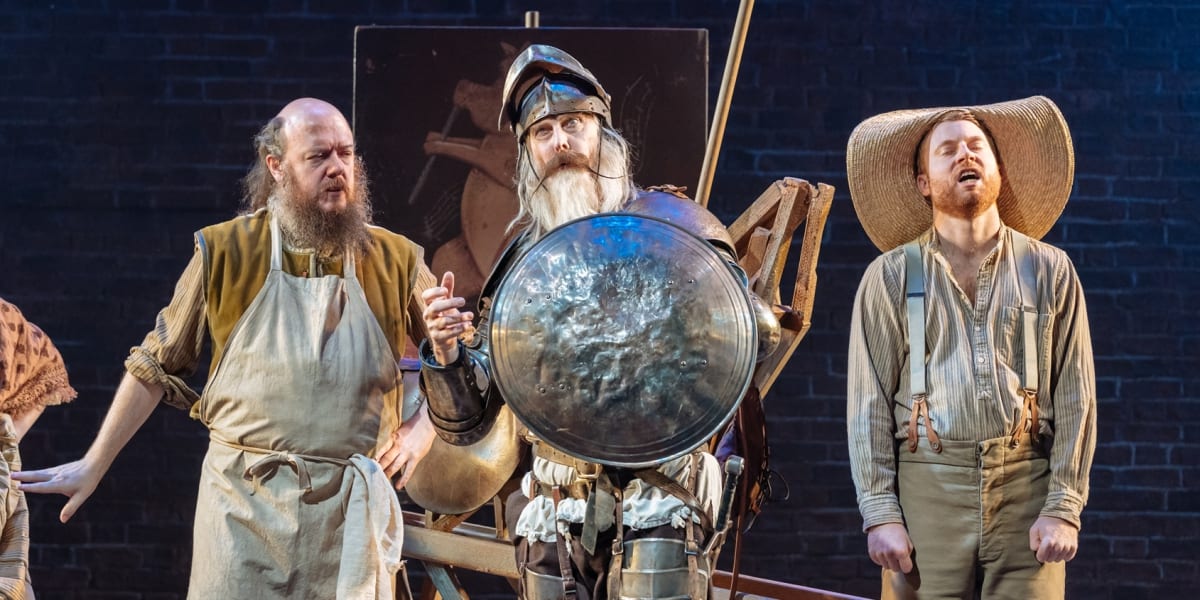The story of the knight-errant of La Mancha and his loyal squire is not only one with which we are familiar, but it is also one that has taken up residence in all art forms. The blend of poignancy and comedy, the plethora of incident and sharply etched characters, and the insight Cervantes offers into the porous, shifting boundaries of fantasy and reality has meant that it can be rediscovered in each generation with fresh rewards.
The core structure is indestructible but still transferable and flexible in the face of new dramaturgy, and fresh directorial perspectives. This long and loving adaptation by James Fenton uses the full resources of the RSC ensemble to recreate in London a highly successful production at the Swan Theatre from a few years back.
The production owes a big debt to three contemporary influences, but it integrates them successfully. The legacy of ‘Monty Python’ and ‘Blackadder’ is very much visible in the farcical and satirical elements of the show and in some of the characterisations, notably of the courtiers, and clergy and peasantry that the Don and Sancho encounter along the way. Also prominent in the first half are elaborate strategies for breaking down the fourth wall between audience and actors that seem to draw on the practice of The Globe, with Rufus Hound’s Sancho very much in the lead: there is a literal bunfight at one point and lots of badinage with people in the front row. The final influence on view, but to good effect, is ‘Warhorse’ which lends ideas and designs to the depiction of the famous steeds, Rocinante and Dapple.
For this long show to work, with its many scenes and shifts of locale and personnel, great fluidity in design is crucial, and this is what Robert Innes Hopkins’ set provides. With the cast playing multiple roles, human and animal, and acting as stagehands too, there is a crack flexibility which means the action never drags. Crucial in setting the atmosphere too are the sumptuous lighting and sound effects produced by Mark Henderson and Fergus O’Hare, and the wonderful sense of timing imparted by specially designated comedy director, Cal McCrystal. There is inventive puppetry too, including a petulant falcon and a sleepy lion. There is also a lot of music. Not all of the songs are memorable or indeed necessary, but none of it is unpleasant, and the crack band placed above the stage plays Grant Olding’s score with aplomb.
At the heart of this show’s success are two beautifully crafted and contrasting performances by David Threlfall and Rufus Hound, reprising their roles from Stratford. They play the comedy deftly as a straight man with a comic foil and gradually transition into pathos in the darker second half once reality bites and the cruelty of the wider world intrudes. They both look the part, with Hound padded out but still agile around the stage, and Threlfall embodying the ‘sad countenance’ of the knight errant’s title before he has uttered a word. There are elements of ‘King Lear’ about Threlfall’s performance, but he finds a dignity and toughness within the role alongside the fantastical Romanticism that raises this performance to distinctive and different emotional heights. Hound has a very big task in generating much of the comic drive in the very long first half, but he finds a lot of inner detail and nuance as the evening progresses. He also deserves great credit for keeping the show on the road during a genuine fire alarm triggered by one of the stage effects. He managed to play it so that we were left unsure where the boundaries of fact and fiction were to be found.
And in this, we find the key to the success of the show. The RSC crack cast keeps us guessing all the way and the sheer level of technical accomplishment and invention ensure that boredom never sets it. This is a great evening to be enjoyed by all ages and deserves to play to packed houses this Christmas.

